How to Easily Check Your TikTok Follower Count History: Insights and Tips
Research TikTok follower count history and analyze growth trends over time. Gain valuable insights into what influences follower changes.

Your TikToks are going viral. You’re seeing people comment on your videos. And that follower graph is steadily increasing.
But is this because of a new content strategy you have adopted? Or did you also see such follower growth changes a few months back?
The only way to find these answers is by checking your TikTok follower count history. You can use TikTok analytics insights or tools like Socialinsider to track this metric.
In this guide, we’ll see how to track TikTok follower count, which tools to use, and how you can tie this metric to other metrics to see the bigger picture. Let’s get started.
Key takeaways
-
TikTok native analytics limitations: TikTok’s native analytics lack historical follower data for large timeframes making it hard to track long-term growth trends.
-
How external tools like Socialinsider help: Socialinsider has created estimates for follower count history, bridging gaps left by TikTok’s native tools.
-
Why correlations with other metrics matter: correlating follower growth with metrics like engagement helps uncover what truly drives audience expansion.
What does TikTok follower count history refer to?
TikTok follower count history refers to the chronological record of how a TikTok account’s follower number has evolved over time. This data goes beyond just showing you the number of followers you currently have. It helps you paint a clearer picture of what’s been working (or not) in your content strategy.
Why tracking TikTok follower history matters?
Follower growth on TikTok might look random from the outside, but it rarely is. When you start tracking how your follower count shifts over time, patterns begin to emerge. And those patterns can lead to smarter social media strategy decisions. Here’s why it matters:
- It helps you assess the effectiveness of your content strategy for driving follower growth. Maybe you post twice a day, lean into trending sounds, or do weekly Lives. But are those efforts paying off? Follower history shows whether there’s a clear correlation between your content strategy and actual audience growth. You’ll start to spot what types of content or posting patterns result in the biggest upticks in followers.
- It enables you to identify effective campaigns over time. Ran a giveaway last month? Collaborated with a creator? By reviewing your follower history during those timeframes, you can easily pinpoint which campaigns moved the needle—and which ones didn’t. This data helps you double down on what works.
- It facilitates a deeper understanding of growth trends. Follower history is like a highlight mark for your account’s growth. Are you growing steadily week over week? Do you see periodic spikes followed by plateaus? Recognizing these trends can help you optimize your posting schedule, format types, or engagement strategies.
- It enables accurate predictions and growth expectations. When you understand how your follower base typically grows, you can start making informed predictions. This is especially useful for reporting, setting realistic KPIs, or pitching future campaigns to stakeholders.
How to leverage native TikTok analytics to get historical follower data?
Want a high-level picture of what your historical TikTok followers? TikTok has built-in analytics that can give you a head start on how to view TikTok followers evolution over time. Let’s see what it offers in detail.
Native TikTok analytics: what it shows and what it misses out on
If you haven't already, you need to switch to a Creator or Business account to check native TikTok follower analytics.
Once that's done, open the TikTok app and go to your profile. Tap the three lines (≡) in the top right corner to access the menu, then select Creator Tools and choose Analytics.
From there, navigate to the Followers tab for detailed information about your audience. If you’re using a desktop, you can directly go to this link.

The main info that you will get from this screen:
- TikTok following count: Shows the total number of people who follow your account.
- Age range: Displays the percentage breakdown of your followers by age group.
- Gender: Indicates the gender distribution of your audience.
- Top locations (cities and countries): Reveals where most of your followers are located geographically.
- Most active times: Highlights the hours and days when your followers are most active on TikTok.
You can even download this data from TikTok Studio in an XLSX or CSV format.
Limitations of native TikTok analytics
One major limitation of TikTok’s native analytics is the lack of detailed follower history.
The platform used to let you view your number of followers for preselected periods—the last 7, 28, or 60 days. Though, they have come out with custom ranges that allow you to define your time periods, a caveat still remains — you can’t see this data beyond a year.
So, if you want to track follower count for TikTok beyond a year, it’s not possible with native analytics.
For example, if you’re trying to understand how a campaign from a year ago affected your follower growth as compared to a similar campaign now, you won’t be able to get this analysis done.
Also, once the time passes, the data can’t be retrieved again unless you have saved it manually. This means you have to be proactive in recording your stats regularly. But there’s a better alternative. Let’s find out.
Why are third-party tools essential for long-term TikTok follower growth tracking?
TikTok native analytics are great for giving you a sneak peek. But they fall short when it comes to helping you dig deep into why a follower spike happened, or if different campaigns have had different impacts on TikTok follower growth over the years.
Here are three more reasons to switch to third-party social media analytics tools to check the evolution of your followers over time.
- Limited time range: Data is only available for the past year. There's no full history view beyond that window. Unless you manually track it, you can lose out on valuable insights.
- No custom or yearly comparison. You can't directly compare specific past periods (e.g., January vs. April). Moreover, there’s no option to compare data across years or track annual growth trends.
- Basic visuals. Growth charts are basic and offer limited customization, which restricts in-depth analysis.
Here’s how tools like Socialinsider are better at follower count history and more.
Extended custom timeframes and analysis
Unlike TikTok’s native analytics, which only shows follower data for a limited time period, Socialinsider offers extended timeframes for in-depth analysis.
One of our standout features is access to estimated historical followers data, even for dates before you connected your TikTok account to the tool. This means you can track TikTok follower count from when the account was created, giving you a complete long-term view of your performance.
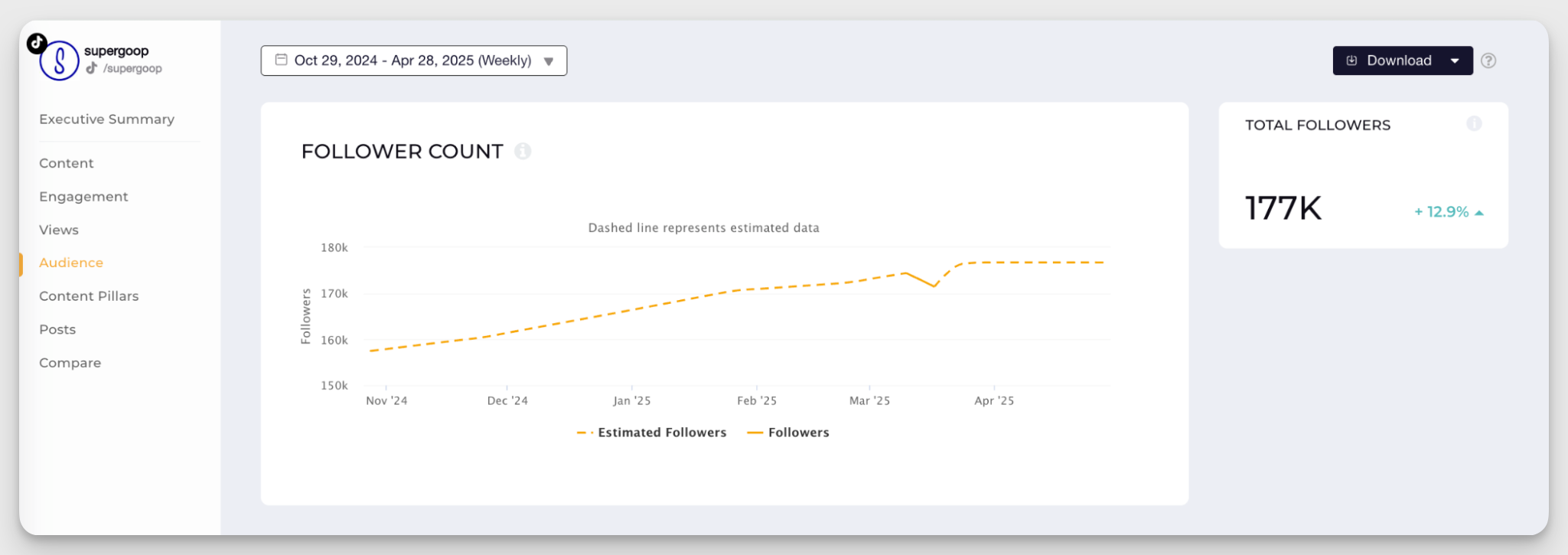
For example, if you want to see how your content strategy attracted followers a year ago, TikTok won’t help. But Socialinsider fills in the gaps with reliable estimates. This extended view is perfect for brands or creators who need to analyze growth trends over quarters or years, not just weeks.
It’s like having a time machine for your profile, making social media strategy planning, reporting, and performance reviews much easier and more data-driven.
Extended metrics for effective progress tracking and benchmarking
Socialinsider goes beyond TikTok’s basic analytics by offering extended social media metrics that help you track progress more effectively and benchmark your performance.
Instead of just looking at TikTok followers history data, you can connect that number with other key insights, like engagement rate, video views, or posting frequency, to understand what drives growth.
For example, if you see a big jump in followers, you can check which videos caused the spike, what times they were posted, etc. This lets you spot patterns and adjust your strategy based on real data.
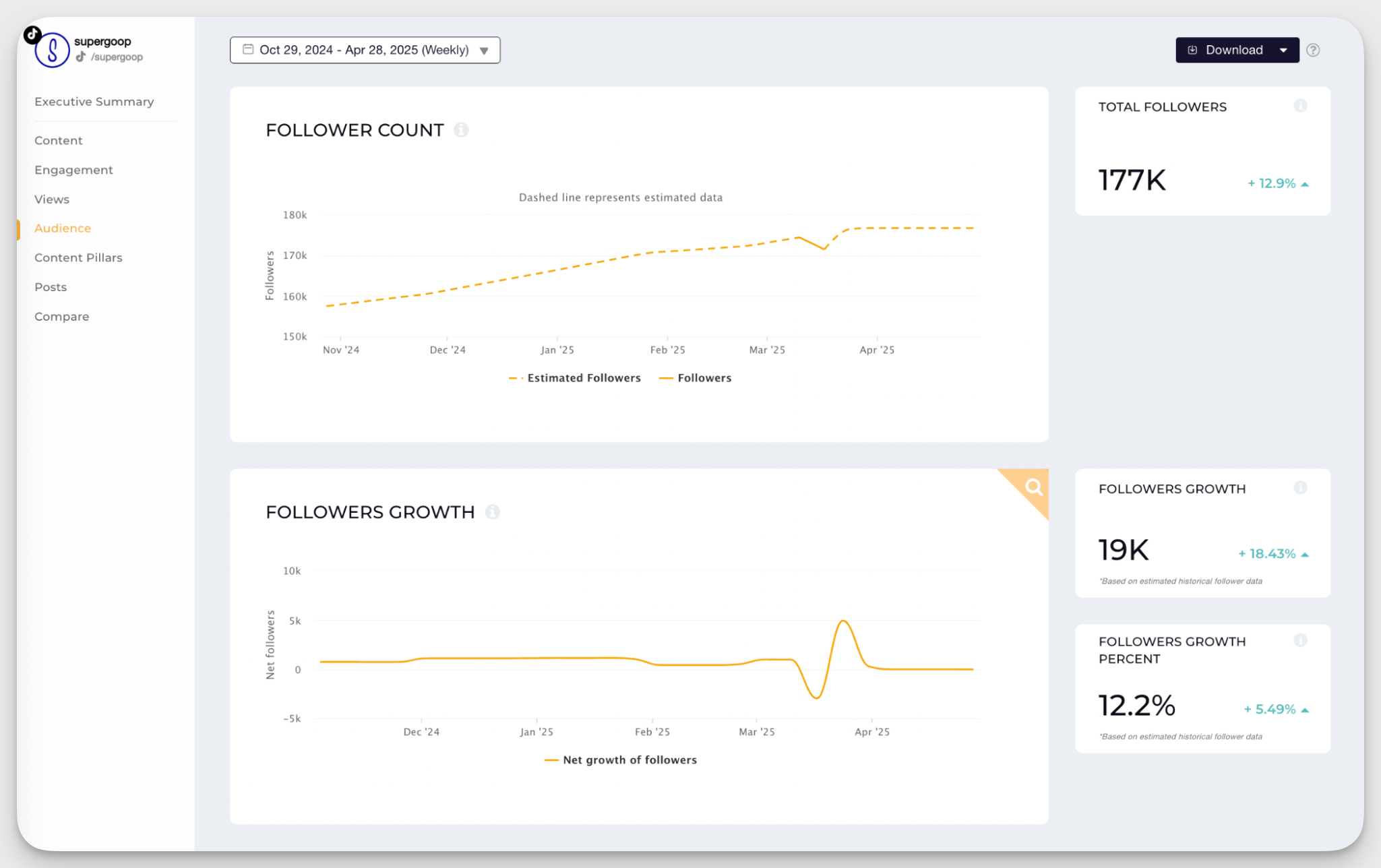
Socialinsider also helps you compare your account to competitors or industry benchmarks, so you can see if your growth is above or below average. This makes follower tracking more intelligent and actionable.
Correlation between content strategy and follower growth
Ever heard the saying, “No man is an island?” The same applies to social media metrics as well.
By basing your analysis on just one metric, you can only go so far. But when you consider it along with other metrics, you understand the deeper relations and impacts.
That’s where tools like Socialinsider help. You can track which videos sparked the most growth by analyzing views, likes, comments, and engagement rates side by side with follower data.
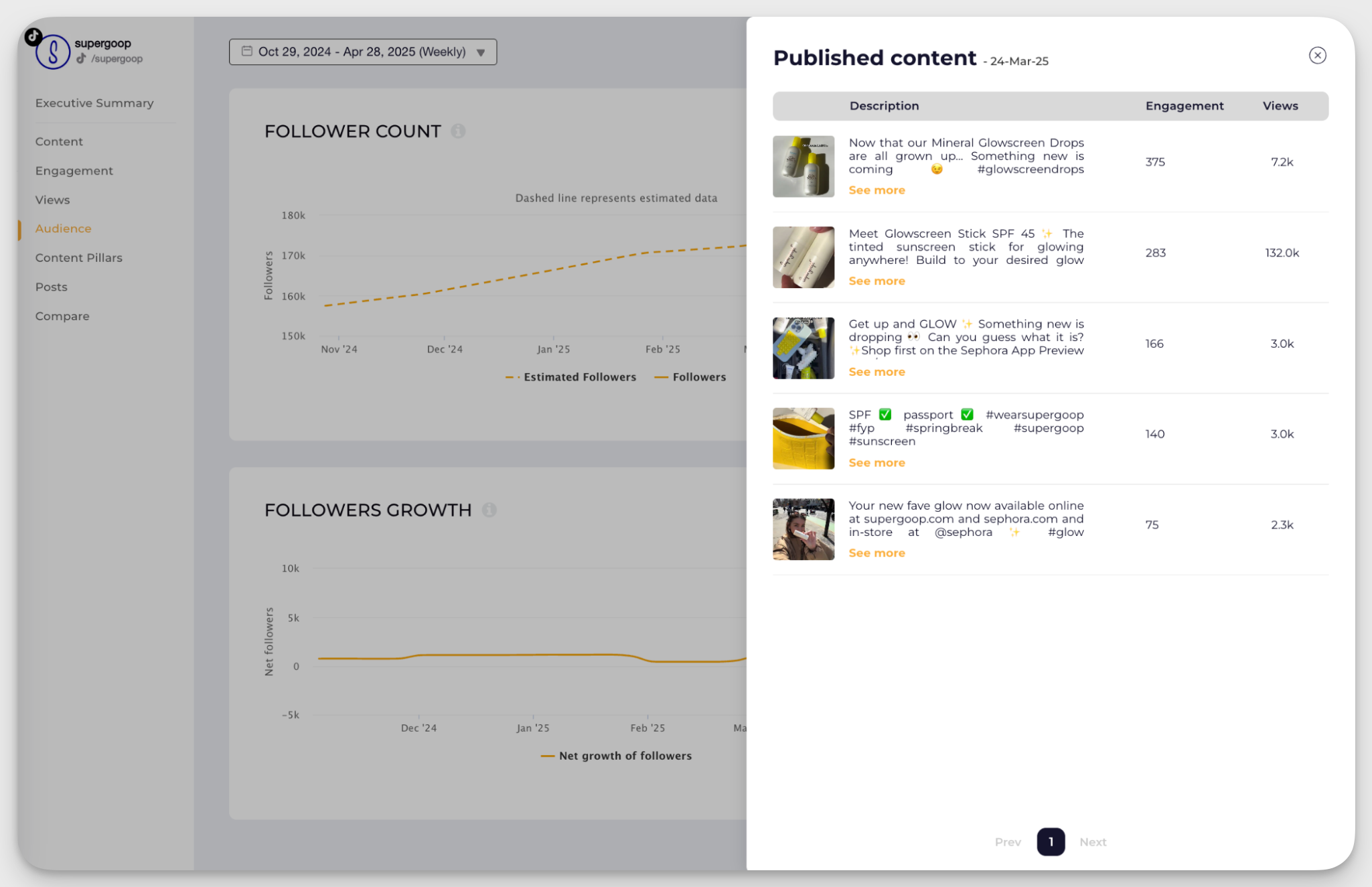
For example, imagine you posted a "Behind-the-Scenes" video, and your account gained 2K new followers over the next days.
With Socialinsider, you can zoom in on that timeframe, spot the spike in engagement for that post, and directly connect it to your follower surge. Maybe that video had a 15% engagement rate increase, or double that of your average. That’s a clear sign this type of content resonates with your audience.
Tools and methods to track TikTok follower count history
Want to see TikTok followers' evolution over time? Here are two methods businesses or creators often use to track TikTok followers over time.
Excel/Google Sheets for manual reporting
Since TikTok’s native analytics show only short-term data, you can use Excel/Google Sheets to monitor follower growth over time. To get started, create a spreadsheet with columns such as date, total followers, change in followers, and notes.
Each day, or at regular intervals (weekly, bi-weekly), record your total follower count from TikTok Analytics. You can calculate the daily or weekly TikTok followers change by subtracting the previous entry’s follower count from the current one.
You can also use charts or graphs in Sheets or Excel to visualize your follower progress, making it easier to analyze performance at a glance.
When to use this method?
- You want a budget-friendly option. This is ideal if you don’t want to pay for third-party analytics tools. Sheets and Excel are freely available.
- You want custom tracking. You can tailor your sheet to include any data you want, like campaign notes, post types, or goals, not just what tools provide.
- You have basic requirements. It’s the best method if you’re a small creator or brand with basic tracking needs.
When not to use this method?
- You need advanced analytics. You won’t get deeper social media insights like estimated historical data for TikTok follower count, content benchmarking, or competitor analysis.
- You have time constraints. If you don't have time to log data consistently, your sheets will be incomplete and less useful for long-term analysis.
- You need reports and visuals fast. If you manage social media for clients, third-party tools help generate polished reports and charts instantly.
Socialinsider for automated reporting
If manually updating a spreadsheet feels overwhelming, Socialinsider provides an automated and efficient solution for tracking TikTok follower growth.
Our social media analytics platform helps you monitor followers over time without any manual input.
You can view follower trends on a clean timeline and even set custom date ranges to analyze how specific content or campaigns impacted your audience growth.
One of the challenges with TikTok is that it offers very limited access to historical follower data through its API. This means that when you connect a TikTok profile to Socialinsider (or any analytics tool), you won’t be able to retrieve the exact follower counts from before the connection date.
To bridge this gap, Socialinsider uses intelligent estimations to help you understand past follower trends, even for periods when the account wasn’t actively tracked. You can get estimated historical followers data for any business account you add to the Socialinsider dashboard.
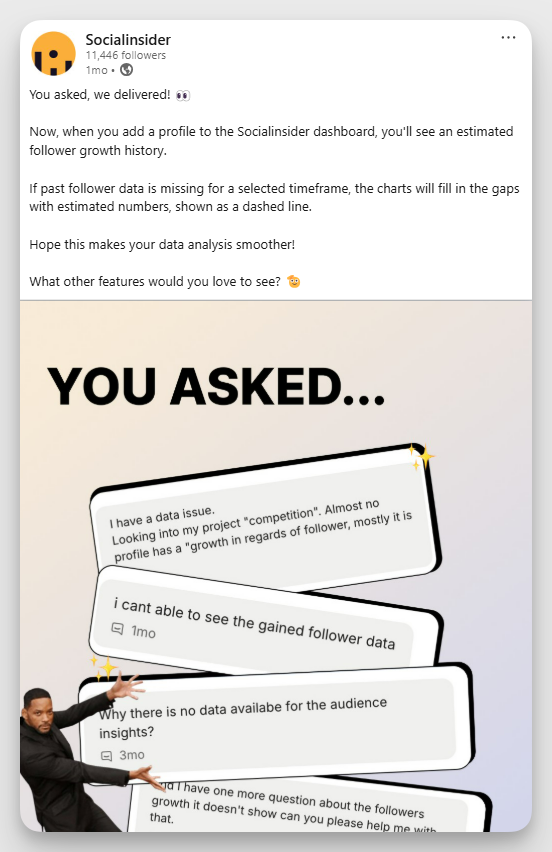
Historical follower data helps you:
- Understand long-term growth patterns even if you just started using our tool.
- Correlate past marketing campaigns or events with follower changes.
- Create more comprehensive reports with complete timelines.
- Benchmark performance against competitors with a fuller dataset.
PS: If you’re looking to switch tools, we can import your historical posts into the Socialinsider dashboard to provide accurate data reporting.
How to analyze and interpret TikTok follower growth data?
A sudden rise in followers? Or a consistent drop? These signs are telling you something about your TikTok marketing strategy. Here’s how to read and analyze these changes.
Identify meaningful trends vs. normal fluctuations
Ups and downs are normal. However, if you see a significant spike/drop in your follower count over a certain (usually short) period of time, you should look into it to see what triggered that spike/drop.
For example, here’s Rhode’s follower growth graph for a specific custom date range.
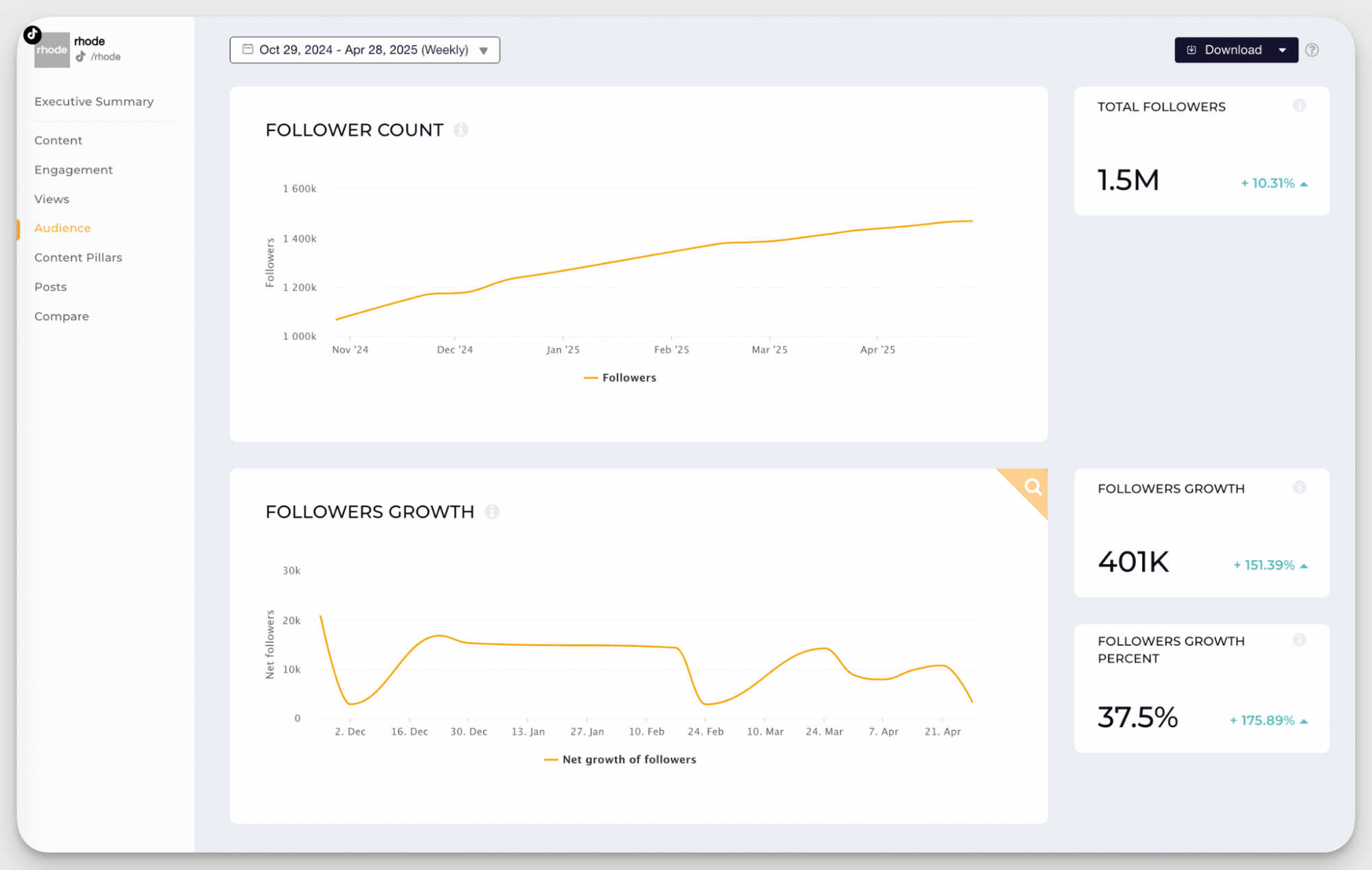
You can see a drop in its growth rate over the first two weeks of December. This may be due to the holiday season. Or it could be an indication that the content leveraged wasn’t the most successful in gaining new followers.
Using Socialinsider, you can quickly check the content posted during this period and see the TikTok metrics they generated.

You can even go one step further and see last year’s metrics for the holiday season. Does a similar pattern show up? If yes, that points to a seasonal trend, meaning follower activity naturally dips during this time each year. But if last year’s growth remained steady, then the drop may be more content-related.
With Socialinsider’s custom date range and historical data capabilities, you can dig into both recent performance and year-over-year comparisons. This helps you distinguish between a normal fluctuation and a meaningful trend that may need action.
Benchmark performance against competitors
Ever wondered if your TikTok follower growth is actually good or just average? One of the best ways to find out is by benchmarking your performance against competitors. This means comparing your follower growth to similar accounts in your niche to see how you stack up.
Tools like Socialinsider make this easy by letting you track competitor profiles and compare follower trends, social media engagement, and content performance side by side.
Going back to Rhode’s example from December, one way to understand whether the drop in followers’ growth was caused by seasonality is to benchmark performance against a competitor. So we took a competitor profile and added it to Socialinsider.
We saw the following graph for the same period.
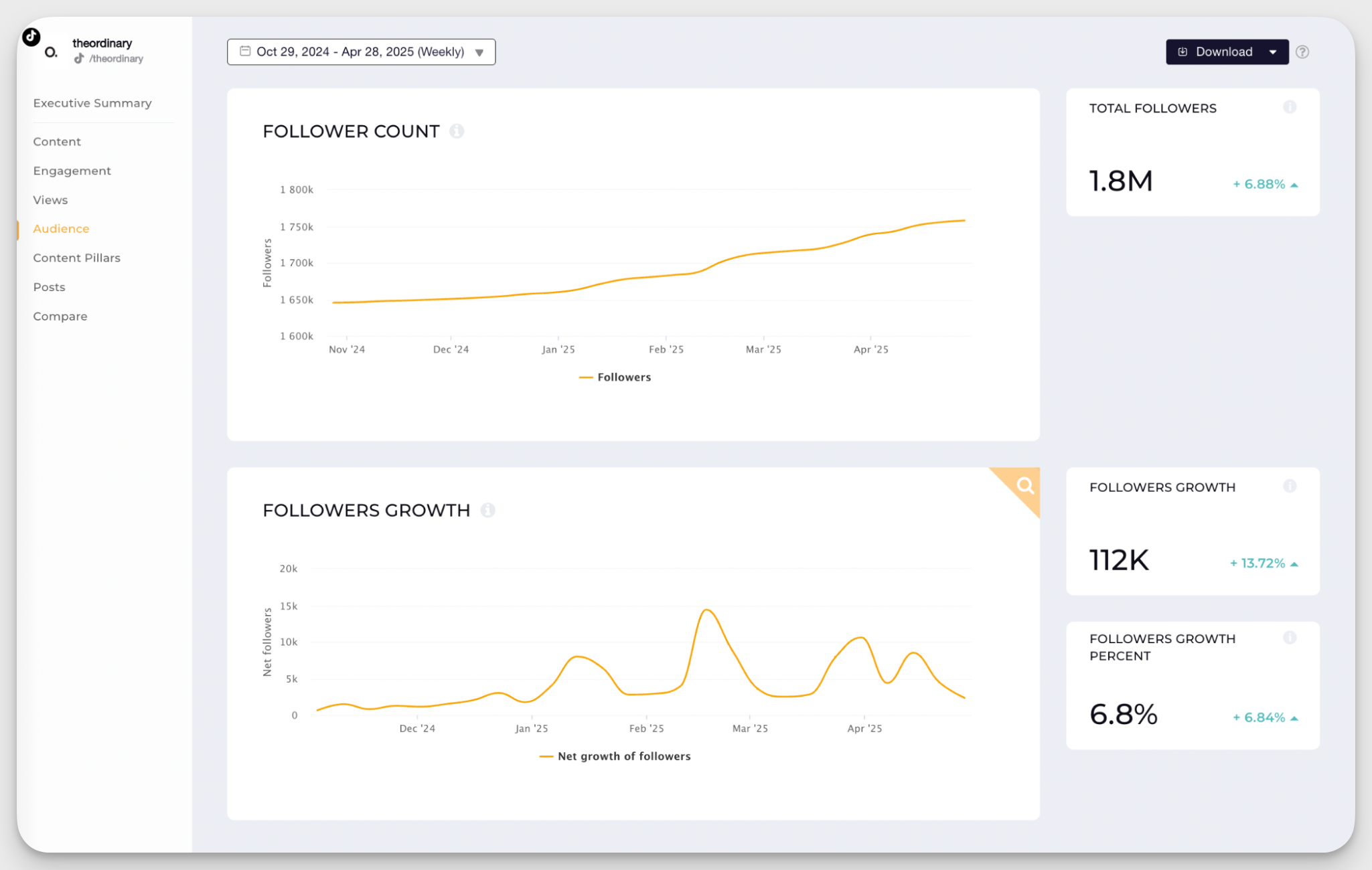
Judging by the numbers, given that one of Rhode’s competitors had an increase in its follower growth trends, we can assume that the content strategy caused the drop in Rhode’s case.
Based on this competitive comparison, you can also:
- See industry patterns: Identify common growth trends across similar accounts, like when follower spikes typically happen or which content formats consistently perform well.
- Find opportunities: Spot gaps in your competitors’ strategies, such as content types they aren’t using effectively, and use those openings to stand out. You can even discover your gaps and make strategies to deal with them.
- Set realistic goals: Use competitor data to define achievable follower growth targets based on what's typical in your niche.
How to correlate TikTok follower growth with engagement metrics
To understand your TikTok growth, it’s important to connect follower increases with social media engagement metrics such as comments or shares. These numbers show not just how many people follow you, but why they chose to.
For example, say you gained 2K new followers in one week. Instead of just celebrating, look back at your posts during that period. Did a specific video get more comments or shares than usual? That’s likely the trigger. High engagement means your content resonated, often leading to more followers.
Take, for instance, Rhodes’ example. We can see that during the same timeframe that the follower growth dipped, the account’s engagement also dropped.
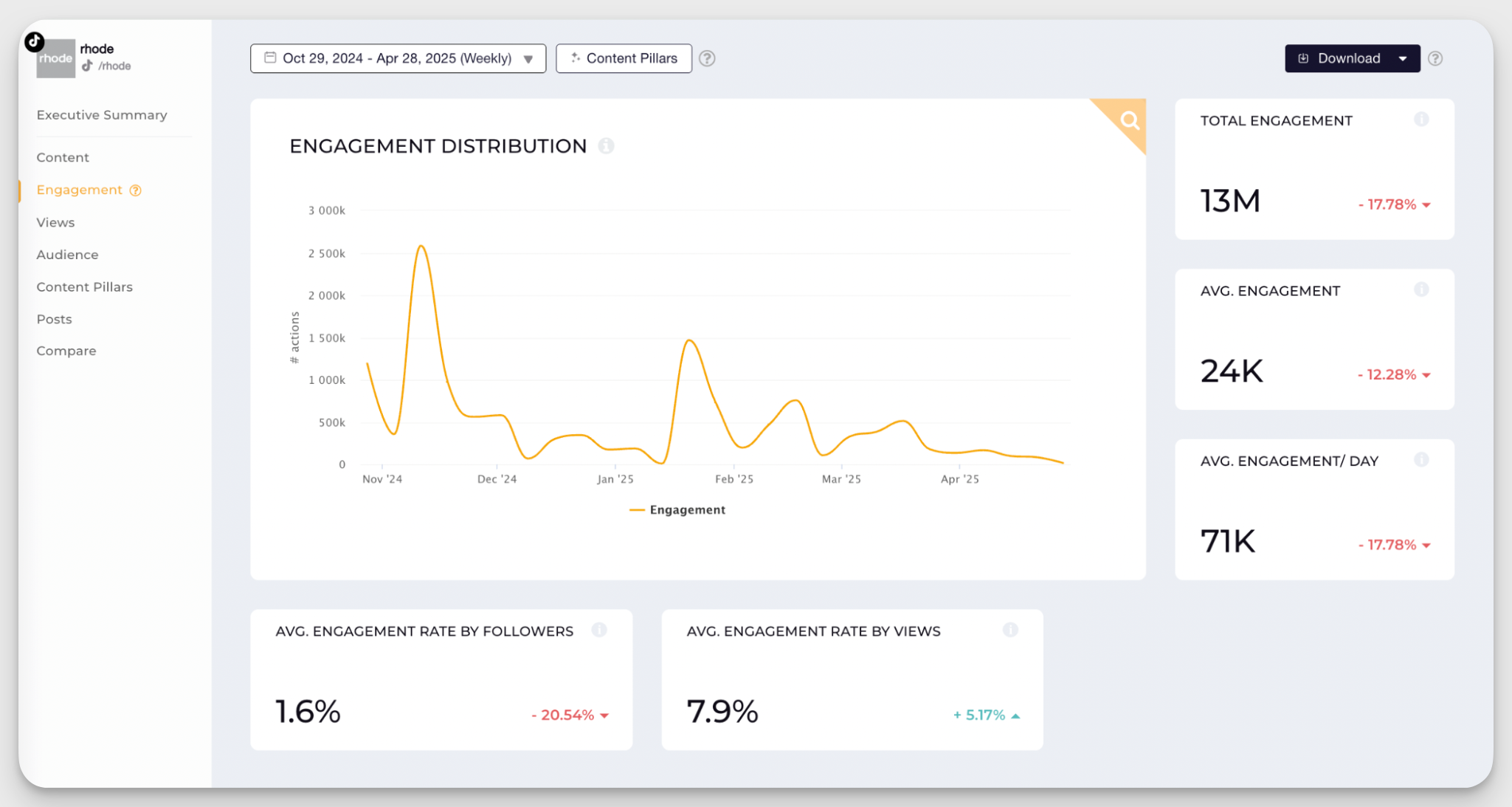
Final thoughts
Tracking your TikTok follower count over time helps you understand what’s working, what’s not, and where to focus your efforts. Instead of just watching numbers go up or down, look at the bigger picture. Connect your content, engagement, and growth trends.
Whether you’re a creator or brand, this insight can guide smarter content decisions and help you grow faster. Manual tracking is a good start, but if you want deeper insights without the extra work, try Socialinsider for free. Click here to activate your free trial.
Analyze your competitors in seconds
Track & analyze your competitors and get top social media metrics and more!
You might also like
Improve your social media strategy with Socialinsider!
Use in-depth data to measure your social accounts’ performance, analyze competitors, and gain insights to improve your strategy.




